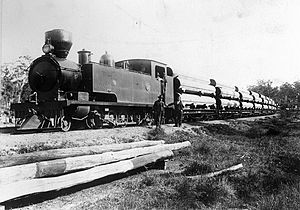2-8-4

Front of locomotive at left
|
|||||||||||||||||||

WAGR K class, c. 1902
|
|||||||||||||||||||
|
|||||||||||||||||||
|
|||||||||||||||||||
|
|||||||||||||||||||
| Equivalent classifications | |
|---|---|
| UIC class | 1'D2 |
| French class | 142 |
| Turkish class | 47 |
| Swiss class | 4/7 |
| Russian class | 1-4-2 |
| First known tank engine version | |
|---|---|
| First use | 1893 |
| Country | Australia |
| Locomotive | WAGR K class |
| Railway | Western Australian Government Railways |
| Designer | Neilson and Company |
| Builder | Neilson and Company |
| Evolved from | 2-8-2T |
| Benefits | Larger fireboxes and coal bunkers |
| First known tender engine version | |
|---|---|
| First use | 1925 |
| Country | United States of America |
| Locomotive | B&A class A1 |
| Railway | Boston and Albany Railroad |
| Designer | Lima Locomotive Works |
| Builder | Lima Locomotive Works |
| Evolved from | 2-8-2 |
| Benefits | Larger firebox than 2-8-2 |
Under the Whyte notation, a 2-8-4 is a steam locomotive that has one unpowered leading axle, usually in a leading truck, followed by four powered and coupled driving axles, and two unpowered trailing axles, usually mounted in a bogie. This locomotive type is most often referred to as a Berkshire, though the Chesapeake and Ohio Railway used the name Kanawha for their 2-8-4s. In Europe, this wheel arrangement was mostly seen in mainline passenger express locomotives and, in certain countries, in tank locomotives.
In the United States of America, the 2-8-4 wheel arrangement was a further development of the enormously successful United States Railroad Administration (USRA) 2-8-2 Mikado. It resulted from the requirement for a locomotive with even greater steam heating capacity. To produce more steam, a solution was to increase the size of the locomotive's firebox, but the 2-8-2 wheel arrangement with its single axle trailing truck limited the permissible increased axle loading from a larger firebox. The most practical solution was to add a second trailing axle to spread the increased weight of a larger firebox.
The first American 2-8-4s were built for the Boston and Albany Railroad in 1925 by Lima Locomotive Works. The railroad's route across the Berkshire mountains was a substantial test for the new locomotives and, as a result, the name Berkshire was adopted for the locomotive type.
In Europe, 2-8-4 tender locomotives were designed mainly for passenger express trains, but they also hauled long distance express freights to increase utilisation. European 2-8-4 tank locomotives were a logical transition from the 2-8-2T locomotive types, allowing larger fireboxes and larger coal bunkers. They were mainly used for busy suburban services in heavily populated suburban areas of big cities, but infrequently also for sparsely populated rural areas or long distance lines.
...
Wikipedia
